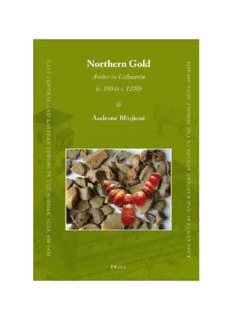
Northern Gold: Amber in Lithuania (c. 100 to c. 1200) PDF
Preview Northern Gold: Amber in Lithuania (c. 100 to c. 1200)
Northern Gold East Central and Eastern Europe in the Middle Ages, 450–1450 General Editor Florin Curta VOLUME 18 The titles published in this series are listed at brill.nl/ecee Northern Gold Amber in Lithuania (c. 100 to c. 1200) By Audronė Bliujienė LEIDEN • BOSTON 2011 Cover illustrations: Front: a compilation of raw amber, a lathed bead and necklace from Užpelkiai. Back: a lathed amber bead from Užpelkiai. © Photographs by Audronė Bliujienė. Language editor: Marianne Noble Translator: Laima V. Sruoginis This book is printed on acid-free paper. Library of Congress Cataloging-in-Publication Data Bliujiene, Audrone, 1954– Northern gold : amber in Lithuania (c. 100 to c. 1200) / by Audrone Bliujiene. p. cm. — (East Central and Eastern Europe in the Middle Ages, 450–1450 ; v. 18) Includes bibliographical references and index. ISBN 978-90-04-21118-6 (hardback : alk. paper) 1. Amber—Lithuania. 2. Excavations (Archaeology)—Lithuania. 3. Jewellery, Prehistoric—Lithuania. 4. Lithuania—Antiquities. I. Title. GN799.A5B55 2011 553.8’79094793—dc23 2011035554 ISSN 1872-8103 ISBN 978-90-04-21118-6 Copyright 2011 by Koninklijke Brill NV, Leiden, The Netherlands. Koninklijke Brill NV incorporates the imprints Brill, Global Oriental, Hotei Publishing, IDC Publishers, Martinus Nijhoff Publishers and VSP. All rights reserved. No part of this publication may be reproduced, translated, stored in a retrieval system, or transmitted in any form or by any means, electronic, mechanical, photocopying, recording or otherwise, without prior written permission from the publisher. Authorization to photocopy items for internal or personal use is granted by Koninklijke Brill NV provided that the appropriate fees are paid directly to The Copyright Clearance Center, 222 Rosewood Drive, Suite 910, Danvers, MA 01923, USA. Fees are subject to change. CONTENTS Acknowledgements ................................................................................... vii List of Figures ............................................................................................ ix List of Appendices .................................................................................... xxxi List of Tables ............................................................................................. xxxiii Chronological System Used in the Book .............................................. xxxv List of Abbreviations ................................................................................ xxxix Introduction ............................................................................................... 1 1. Baltic Amber: Distribution, Main Sources and Accessibility .... 5 2. Amber in Lithuanian Historiography ............................................ 15 3. The Aestii and the Glesum Epoch .................................................. 35 4. Amber in Medieval Lithuania ......................................................... 203 Conclusions ............................................................................................... 335 Appendices and Tables ............................................................................ 353 Bibliography ............................................................................................... 379 Index ........................................................................................................... 407 ACKNOWLEDGEMENTS This work on amber is based on extensive Lithuanian archaeological evi- dence: excavation reports and data from different archives and museums. This work would never have come into existence without the assistance of my Lithuanian and foreign colleagues, who granted me permission to use their unpublished research, gave me advice and constructive criticism, and who pointed me in the direction of relevant materials and archives. I would like to sincerely thank my colleagues, who were particularly support- ive of this work: Dr Audrius Astrauskas, Professor Jan Bemmann, Dr Anna Bitner-Wróblewska, Ramunė Bračiulienė, Donatas Butkus, Professor Claus von Carnap-Bornheim, Jānis Ciglis, Professor Florin Curta, Gytis Grižas, Grażyna Iwanowska, Professor Eugenijus Jovaiša, Habil. Dr Michel Kazanski, Vida Kliaugaitė, Habil. Dr Anna Mastykova, Dr Algimantas K. Merkevičius, Dr Magdalena Natuniewicz-Sekuła, Professor Jerzy Okulicz-Kozaryn, Mirja Ots, Alfreda Petrulienė, Habil. Dr Dieter Quast, Dr Arnis Radiņš, Dr Chris- tine Reich, Vidas Semėnas, Dr Valdemaras Šimėnas, Konstantin Skvorzov, Dr Jonas Stankus, Laimutė Valatkienė, Dr Vykintas Vaitkevičius, Algirdas Varnas, Dr Ernestas Vasiliauskas and Jevgenijus Žikulinas. I would also like to thank the following museums: The Lithuanian National Museum in Vilnius, History Museum of Lithuania Minor in Klaipėda, the regional museums of Kretinga, Panevėžys and Švenčionys “Nalšia”, the Lat- vian National History Museum in Riga, the State Archaeological Museum in Warsaw, the Museum of Prehistory and Early History in Berlin, the Roman- Germanic Central Museum in Mainz and Rheinisches Landesmuseum in Bonn. I am grateful to the publisher Versus aureus for permission to make use of several illustrations from my book Lietuvos priešistorės gintaras (Lith- uania’s prehistoric amber). LIST OF FIGURES 1. Area of the distribution of Baltic amber-bearing sediments: 1 primary amber deposits; 2 amber from Paleogene deposits; 3 boundary of distribution of re-deposited amber. I Sambia (Kaliningradskaia oblast, Russia); II Chłapowo (Poland); III Grodno (Belarus) and IV Obuchov (Ukraine) amber deposits. Map redrawn after Vladas Katinas, Iantar’ i iantarenosnye otlozheniia v iuzhnoi Pribaltiki, fig. 12 .................................................. 6 2. Amber gatherers with scoop nets. After Elżbieta Choińska- Bochdan, “Bursztyn w kulturze”, fig. II.3 .............................................. 7 3. Fragment of Olaus Magnus map “Carta marina et descriptio septemtrionalium terrarium ac mirabilium rerum in eis contentarum diligentissime elaborate” (Venice, 1539). Map showing the Gdańsk Bay, Vistula Lagoon and Spit (formerly Frische Nehrung, or Aistmarės Spit in Lithuanian) and the Sambian Peninsula with “amber coast”. Map fragment enlarged. After Barbara Kosmowska-Ceranowicz and Teresa Pietrzak, “Z dziejów rozwoju wiedzy o znaleziskach bursztynu”, fig. 4 ........... 10 4. “Amber Routes” after Jose Maria de Navarro, “Prehistoric Routes between Northern Europe and Italy Defined by the Amber Trade”, plate I: + main route: early Bronze Age; . . . western route branch: middle Bronze Age;—eastern route: early Iron Age ............. 23 5. Aestii/Balt Roman period cultural groups: 1 The West Lithuanian Stone Circle Graves culture and its peripheral zone the Southwestern Latvian Burial Sites; 2 The Lower Neman Grave Fields; 3 The Collective Barrows culture or the North Lithuanian and South Latvian Barrows culture; 4 The Central Lithuanian Grave Fields; 5 The Southeastern Lithuanian Burial Sites; 6 The East Lithuanian Barrows culture; 7 The Dollkeim-Kovrovo culture; 8 The Bogaczewo culture; 9 The Sudovian culture. Schematic map prepared by the author with additions, after Moora, Die Eisenzeit in Lettland bis etwa 500 n. Chr. II, fig. 90; Adolfas Tautavičius, “Lietuvos TSR archeologijos atlasas”, map 1; Wojciech Nowakowski, “Kulturowy krąg zachodniobałtyjski w okrese wpływów rzymskich”, fig. 1; Rasa Banytė-Rowell, “Romėnų įtakos laikai ir baltų kultūrų klestėjimo laikotarpis”, fig. 9 ............................................................................................................. 37
Description: